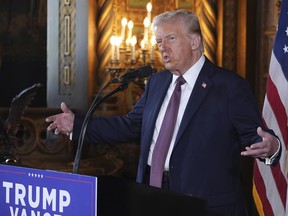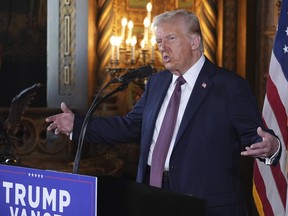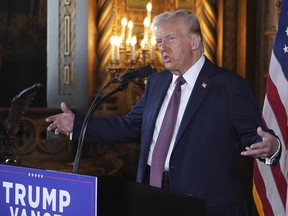A U.S. president-elect has raised the stakes in a provocative exchange over Canada’s status, signaling that Washington could use “economic force” to reshape the continent’s long-standing political and trade ties. As tensions escalate, Washington’s rhetoric about tariffs and strategic leverage has drawn swift responses from Ottawa, the Canadian public, and political leaders alike, underscoring how deeply entwined the U.S.-Canada relationship remains—economically, politically, and security-wise. The episode also revisits long-standing questions about the balance between national interests and continental integration in an era of shifting global dynamics.
The Mar-a-Lago remarks and the case for economic force
U.S. president-elect Donald Trump intensified his remarks about making Canada part of the United States during a press conference at his Mar-a-Lago resort in Florida. He reiterated plans to impose substantial tariffs on goods from Canada and Mexico, framing the issue in stark, strategic terms. When asked whether he would consider military action to annex Canada, Trump offered a clear, provocative answer: no military action, but “economic force.” He explained that removing the artificial political line between the two countries would illuminate what a merged economic and security landscape might look like, arguing that such a union would also bolster national security because Washington “basically protects Canada.”
Trump’s language underscored a broader theme in his remarks: the use of tariffs and other policy tools to recalibrate the U.S.-Canada relationship. He claimed that the United States was subsidizing Canada to the tune of roughly US$200 billion a year, a figure that he framed as evidence of an imbalanced arrangement supported by broader trade dynamics. While no official tally aligns with that precise figure, the assertion reflected his broader critique of trade balances and the uneven advantages he claimed the United States conferred on Canada through integrated supply chains and cross-border commerce. In parallel, Trump highlighted the U.S. dependence on Canadian energy, noting that the United States purchases more than four million barrels of Canadian crude oil in certain months, a figure that reinforces how deeply the two economies are interlinked in the energy sector.
The remarks came amid broader discussions of how the United States imports and subsidizes various Canadian goods, and they touched on a controversial, highly charged issue: the economic calculus behind cross-border trade. The policy option of tariffs was not treated as a mere economic instrument but as a lever to renegotiate a relationship the Trump administration sees as problematic. The emphasis on “economic force” rather than military means signaled a strategic pivot: Washington would pursue leverage through tariffs, quotas, and other non-military tools to drive a new settlement on rules of origin, supply chain dependencies, and cross-border security commitments. The framing suggested a recalibration of the tariff regime between the two neighbors that could extend beyond Canada to other parts of North America, with Mexico as a related but distinct axis of discussion.
Trump’s assertions regarding national security and the cross-border relationship were anchored in a broader narrative about continental protection and the practicalities of defense and energy security. He argued that the United States shoulders a protective burden for Canada, a perception that has long shaped North American diplomacy. Yet his emphasis on “economic force” as a primary instrument for achieving policy goals reframed the debate: could currency, tariffs, and industrial policy drive a redefinition of sovereignty, borders, and economic alignment in ways that would resemble a state-to-state arrangement? The remarks were widely interpreted as a provocative attempt to force Canada to confront a reality he described as both strategically advantageous and economically rational from a U.S. perspective.
The economic deficit, trade flows, and Canada’s role in the U.S. economy
Trump’s remarks also touched on a contentious interpretation of the U.S. trade balance with Canada. He asserted that the United States subsidizes Canada by a substantial amount, a claim that framed his proposed tariff policy as a response to what he characterized as an unfair arrangement. To ground that claim in context, it’s important to note the official data on the U.S. trade deficit in goods and services with Canada. In 2023, the total U.S. trade deficit with Canada stood at US$40.6 billion, reflecting a complex set of factors, including energy trade, manufacturing, and other cross-border exchanges. Energy exports have been a central driver of the bilateral relationship, with the United States relying heavily on Canadian crude oil in certain months, averaging more than four million barrels per day in peak periods.
Trump’s framing of the deficit was meant to illustrate perceived imbalances in how resources flow across the border. The implication is that if Canada and the United States could rethink the arrangements governing energy, manufacturing, and broader trade, the balance could be shifted in ways that align more closely with U.S. strategic and economic priorities. The discussion of “subsidies” suggested a broader critique of how policies, incentives, and cross-border investment shapes the two economies, pushing the conversation beyond simple tariff calculus to examine the structural underpinnings of North American trade.
Beyond energy, several sectors anchor the Canada-U.S. trade relationship. Canada has been a critical supplier of raw materials and intermediate goods that feed U.S. manufacturing, including the mining, energy, and agricultural sectors. The interdependence extends to the auto sector, where parts and vehicles cross the border in a tightly integrated supply chain. The prospect of imposing significant tariffs on Canadian goods raised concerns about supply chain disruption, price volatility for consumers, and the potential for retaliatory measures that could ripple through both economies. In this context, the discussion about tariffs is not merely about one policy instrument; it is about a broader rethinking of how the two countries coordinate on energy policy, industrial strategy, and cross-border investment.
Analysts observing the exchange noted potential implications for currency markets and exchange rates, as cross-border policy shifts can alter investor expectations and the competitiveness of exports and imports. A shift toward higher tariffs could alter relative prices, tilt the balance of trade, and affect the profitability of Canadian exporters and sectors dependent on U.S. markets. The conversation also raises questions about how Canada would respond to aggressive U.S. measures, including whether Ottawa would deploy countermeasures such as export taxes on strategic commodities to blunt tariff-induced damage or to preserve national interests in critical sectors like energy and minerals.
Political reactions in Canada: public opinion, leadership, and party dynamics
The remarks from Trump elicited a rapid and forceful response from Canadian leaders and the public. A prominent line from Prime Minister Justin Trudeau, who had previously dismissed the idea of Canada becoming part of the United States, was echoed in a public statement: “There isn’t a snowball’s chance in hell that Canada would become part of the United States.” The sentiment captured the core of Canadian political and public opinion, underscoring a broad consensus against any notion of ceding sovereignty or redefining national identity in such a dramatic way. The emphasis on sovereignty and national pride resonated across political lines, reinforcing the message that Canada would not entertain any arrangement that would threaten its independence.
Public opinion data cited by Canadian officials and media indicated that a majority of Canadians oppose the idea of annexation or a 51st state status. In a country with a strong tradition of parliamentary democracy and federal-provincial autonomy, the concept of surrendering political sovereignty to a neighbor is viewed with skepticism and concern regarding economic, social, and security implications. The political reaction extended beyond the prime minister. Ministers and party leaders responded through official channels, social media, and public statements, emphasizing Canada’s commitment to defending its constitutional framework and its status as a sovereign nation within the bilateral relationship.
Within Trudeau’s government, the lines between policy and political messaging became part of the broader discourse around the U.S.-Canada relationship. Some officials had previously suggested that the 51st state remark was a joke or a rhetorical device rather than a serious policy proposal. Nevertheless, the comments prompted a renewed emphasis on defending Canada’s sovereignty and the value of the bilateral relationship that has underpinned North American economic integration for decades. The political conversation also touched on the broader implications for Canada’s strategic posture, including how Ottawa would respond to U.S. policy shifts and what steps could be taken to preserve access to essential markets and resources while safeguarding national interests.
On the domestic front, the Canadian political landscape was already facing significant questions about leadership and electoral direction. Prime Minister Trudeau announced his resignation, stating that he did not have sufficient support within the Liberal Party to lead into the upcoming election. The resignation and the leadership transition added another layer of complexity to how Canada would navigate potential trade tensions with the United States. In this context, Foreign Minister Mélanie Joly issued messages on social media, reaffirming Canada’s resolve not to back down in the face of threats and signaling a commitment to defending Canadian interests through diplomacy, policy measures, and targeted responses where necessary. The interplay between leadership changes and international tensions shaped the media narrative and influenced how Canadians perceived the risks and opportunities associated with cross-border economic and security arrangements.
Opposition voices in Canada also weighed in on the discussion. Pierre Poilievre, the Conservative Party leader who polls suggested was the frontrunner for the next election, asserted that Canada would not become part of the United States and warned against giving ground in any negotiations that could compromise Canada’s autonomy. The political debate in Canada thus spanned public opinion, party platforms, and the practical realities of how Canada would respond to heightened U.S. policy pressure. The consensus among many Canadian commentators was that while the relationship remains essential for economic growth and security, it must be managed in a way that preserves sovereignty, protects core industries, and ensures diversified trade that does not excessively hinge on a single neighbor.
Policy options, economic implications, and the spillover for North American markets
The rhetoric around tariff policy and economic leverage opened up a broader discussion about what measures could be employed to recalibrate the bilateral relationship without triggering a full-scale trade war. Ottawa, mindful of its own economic interests and dependence on U.S. markets, began evaluating potential policy responses that could mitigate the impact of U.S. actions on key Canadian exports. Among the options discussed in policy circles were export taxes on certain Canadian commodities, including uranium, oil, and potash—a potential lever to temper tariffs or respond to perceived U.S. protectionism. The idea would be to ensure that Canada retains some control over the price and flow of its most strategic resources, while also signaling that the country would take necessary steps to defend its economic interests.
The possibility of 25 percent tariffs on Canadian goods, as hinted at in Trump’s remarks, raised questions about the risk of a broader trade confrontation. Analysts noted that such tariffs could have cascading effects throughout North American supply chains, especially in sectors where cross-border integration is highest. The auto sector, which relies on a continental supply chain, could see delays, cost increases, and potential shifts in production strategies if tariffs were imposed or if the terms of trade were renegotiated. In the event of heightened tariff activity, there would likely be a push to diversify suppliers, alter sourcing strategies, and expedite the reevaluation of cross-border investment plans to reduce exposure to tariff-induced risk.
Lumber and timber products appeared as a focal point in discussions about domestic policy adjustments and executive actions. Trump suggested the possibility of issuing an executive order to “un-restrict” lumber, a move that would aim to unlock U.S. access to more Canadian timber or to restructure cross-border timber policy to advance domestic sources and reduce dependency on Canada for wood products used in construction and manufacturing. The practical implications of such a policy would span the construction sector, housing markets, and the manufacturing of wood-based products, potentially influencing price levels and the availability of timber for consumers and businesses in both countries.
In the event of a U.S.-led push toward heightened tariffs or stricter border controls, Canada’s strategy would likely include a mix of retaliation, targeted protections for critical industries, and diversification of export markets. While the energy sector remains a cornerstone of the bilateral framework, Canada would need to balance the short-term costs of policy responses with long-term goals of maintaining access to American markets while pursuing new markets abroad. The dynamic would push Canadian policymakers to accelerate diversification, invest in value-added processing within Canada, and strengthen trade ties with European, Asian, and other partners to offset potential losses from a misaligned North American policy stance.
A broader structural consideration concerns the integrity and resilience of the North American energy and manufacturing ecosystems. The United States is a major consumer of Canadian energy and a crucial partner for Canada’s key commodities, including oil, uranium, and potash. Any disruption to the cross-border flow of these resources would reverberate through energy markets, nuclear power generation, fertilizer supply chains, and related industries, with ripple effects on prices, investment plans, and project timelines. Currency markets would also react to policy shifts, as the Canadian dollar’s value is sensitive to changes in cross-border demand, commodity prices, and expectations about future policy directions. A sustained period of tariff uncertainty could depress the value of the loonie, complicating Canada’s macroeconomic management and trade planning.
The political ramifications of policy moves would extend beyond the immediate economic realm. Ottawa would need to navigate a complex web of domestic political considerations, including party positions, cabinet alignments, provincial interests, and public opinion. In a scenario of intensified cross-border tensions, leaders would face pressure to demonstrate resilience, protect domestic industries, and maintain the confidence of Canadian voters who expect steady leadership and a credible plan for safeguarding economic growth. The possibility of leadership changes in Canada added an extra layer of uncertainty, as new policymakers would bring different priorities and strategies to bear in the negotiation table with Washington.
Canada’s strategic dependencies and the currency dimension
Canada’s export profile underscores how essential the bilateral relationship is to both economies. The country is a major external supplier of oil to the United States, a pipeline of energy that has historically been central to American energy security. Canada’s uranium is a crucial source of fuel for U.S. nuclear power plants, highlighting the country’s role in maintaining the reliability and diversity of U.S. energy generation. Potash from Canada is a critical input for American agriculture, supporting crop yields and food production across multiple states. These dependencies center Canadian economic policy and cross-border trade in ways that heighten sensitivities to policy shifts or punitive tariff measures.
In the wake of Trump’s comments, the Canadian dollar declined modestly against the U.S. dollar, reflecting market responses to the tariff discussion and the broader policy risk associated with cross-border tensions. The loonie traded at around C$1.4344 to the U.S. dollar in mid-day trading, illustrating how financial markets react to policy signals and exchange-rate expectations in a tightly linked regional economy. The currency reaction, while not catastrophic, signals how quickly market sentiment can adjust to evolving policy landscapes and cross-border risk.
Within Canada’s political context, leadership dynamics and strategic messaging further shaped responses to the tariff talk. Trudeau’s resignation added a new dimension to the policy debate, as a transition in leadership could influence Canada’s negotiating posture and its ability to align domestic priorities with international considerations. The Foreign Minister’s social-media statements underscored a commitment to standing firm in defense of Canada’s interests, reinforcing the message that the government would not back down in the face of threats, while also signaling preparedness to navigate any tariff-related disruption through policy tools and diplomatic channels.
Conservative voices in Canada, led by party leadership candidates who polls suggested were likely to assume power, echoed a firm stance against yielding sovereignty or compromising national autonomy. This framing helped anchor public expectations that Canada would resist any policy moves perceived as coercive or punitive, while continuing to pursue a robust and diversified trade strategy. The political and economic calculus in Canada thus centers on a careful balancing act: defending sovereign prerogatives, maintaining access to essential markets, and pursuing new opportunities to offset any potential losses from heightened U.S. protectionism.
Outlook for North American trade, politics, and policy
Looking ahead, the potential for a sustained policy shift in the U.S.-Canada relationship remains a central concern for policymakers, businesses, and workers on both sides of the border. The conversation is likely to evolve as Ottawa and Washington engage in further dialogue, assess the practical implications of proposed policy options, and explore avenues for safeguarding cross-border commerce while preserving the integrity of national policy frameworks. The likelihood of a negotiated settlement that addresses tariff concerns while preserving core trade flows remains uncertain, with the risk of escalation if tariff proposals become more concrete or if retaliatory measures are contemplated.
In Canada, the political landscape will influence how the country responds to any shift in U.S. policy. A leadership transition could bring new priorities, including how to bolster domestic manufacturing, secure strategic resources, and diversify export markets beyond the United States. The balance between vulnerability to U.S. demand and resilience through diversification will continue to shape policy decisions, investment strategies, and long-term planning. Public sentiment, reflected in polls and parliamentary discourse, will contribute to the tempo and direction of negotiations and policy responses, particularly if cross-border tensions persist or intensify.
For the United States, the framework of cross-border policy remains critically important to national security and economic objectives. The emphasis on economic leverage as a tool of policy signals a willingness to use tariff instruments to recalibrate the relationship, but it also raises concerns about the potential for a broader trade conflict that could harm American consumers, manufacturers, and energy markets. The cross-border energy relationship, in particular, is a linchpin of both economies, and any policy shifts affecting energy flows would have far-reaching consequences for North American energy security, pricing, and investment activity.
As the two countries navigate these complex issues, the overarching objective for both sides is to preserve the advantages of their deep, interconnected economies while ensuring that policy choices reflect mutual interests and shared regional priorities. The path forward will likely involve a combination of tariff policy, export controls, and strategic diplomacy designed to prevent disruption to essential supply chains, protect critical industries, and maintain the stability needed for long-term growth. In this evolving scenario, Canada’s resilience, strategic diversification, and commitment to sovereignty will be tested, while the United States faces the challenge of balancing assertive policy moves with the realities of an integrated continental economy.
Conclusion
The exchange over whether Canada could become part of the United States has resurfaced amid a broader debate about trade, sovereignty, and economic strategy in North America. Trump’s insistence on employing “economic force” to press for a recalibrated relationship has underscored how deeply policy instruments—tariffs, export controls, and strategic energy considerations—are now viewed as levers of power in shaping cross-border arrangements. Canada’s response has been firmly anchored in defending sovereignty and preserving the long-standing, mutually beneficial alliance that has underpinned economic growth, energy security, and political partnership for decades. Public opinion and political leadership in Canada have coalesced around a cautious, principled stance that rejects the notion of annexation or surrender of national autonomy, even as both countries recognize the tangible economic links that bind them together.
The trajectory of this dispute will hinge on the ability of policymakers to translate rhetoric into practical policies that safeguard core industries, stabilize supply chains, and maintain the open, rules-based framework that has fostered decades of cross-border prosperity. Ottawa faces the task of balancing sovereignty with pragmatic cooperation, while Washington must consider the broader consequences of tariff-driven strategies on North American markets and global supply chains. In the end, the U.S.-Canada relationship remains a defining factor in both nations’ futures, with the potential for significant real-world implications depending on how policymakers navigate the delicate intersection of national interests, economic leverage, and the enduring realities of continental integration.




